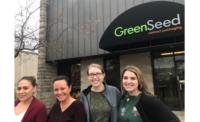Women Exploring New Territory in Packaging, Manufacturing and Beyond




Ellen Ochoa, the first female Hispanic astronaut, was the keynote speaker at the Packaging & Processing Women’s Leadership Network breakfast at PACK EXPO Las Vegas.
There was a buzz in the air at the Packaging & Processing Women's Leadership Network (PPWLN) breakfast at PACK EXPO Las Vegas. The 700 attendees were there to see keynote speaker Dr. Ellen Ochoa, the first Hispanic woman to go into space, and to hear about her extraordinary journey. Fittingly, the theme of the breakfast meeting was “Exploring New Territory.”
Ochoa spoke to the mostly female, PACK Expo Las Vegas audience about her path to becoming an astronaut and working in a field that — like manufacturing — has been traditionally held by men until recently.
Ochoa joined NASA in 1988 (nine years after the institution first started hiring women to train as astronauts*) as a research engineer at Ames Research Center and moved to Johnson Space Center in 1990 when she was selected as an astronaut. She flew on the nine-day mission aboard the space shuttle Discovery in 1993 and has flown in space four times, logging nearly 1,000 hours in orbit.
Born in California, Ochoa was the top math student in her high school, yet no one suggested she pursue a career in math or science. While attending San Diego State University, she was curious about physics but did not fully understand what careers a physics background would yield. She told the audience that the first step to having more women in a male-dominated field was to simply explain what career opportunities are available in that industry.
After being encouraged by a professor who explained that “math was the language of physics,” Ochoa went on to earn a bachelor's degree in physics from San Diego State University and a master's degree and doctorate in electrical engineering from Stanford University. It’s an amazing accomplishment — considering less than a decade before, women in the U.S. could not legally open a bank account in their own name (a husband’s or other male’s name was needed) or serve on a jury in some areas of the country.
Ochoa stressed the importance that young women know the history of both the suffrage movement that ultimately got women the right to vote in 1919, and the second wave of feminism in the 1970s and how those women made it possible for her — and all women — to explore new career paths.
Ochoa shared the story of when she served on the nine-day mission aboard the space shuttle Discovery in 1993 as a mission specialist making her the first Hispanic women in space. She brought a historic women's suffrage banner with her on the mission to honor those who had long fought for equal rights and made her journey possible.
Packaging Strategies Editor in Chief Kristen Kazarian asked Ochoa what career challenges she faced as a woman. “At NASA I was an equal in my positions. My team members and bosses believed in me.” She went on to say, “Most of the people who don’t believe in you or discourage you from trying anything don’t know you well or know what you are capable of doing. Listen instead to those who know you and believe in you.”
Today, women make up about one-third of the astronaut pool. There still is a need to encourage more young women to enter into male dominated fields such as manufacturing. The Packaging and Processing Women’s Leadership Network serves to recruit, retain and advance women's careers in packaging and processing.
*While NASA didn’t have an actual ban on women becoming astronauts before the 1970s, their guidelines took women out of the process. Part of this was because NASA only accepted military applications and the military didn’t take women.
Looking for a reprint of this article?
From high-res PDFs to custom plaques, order your copy today!








